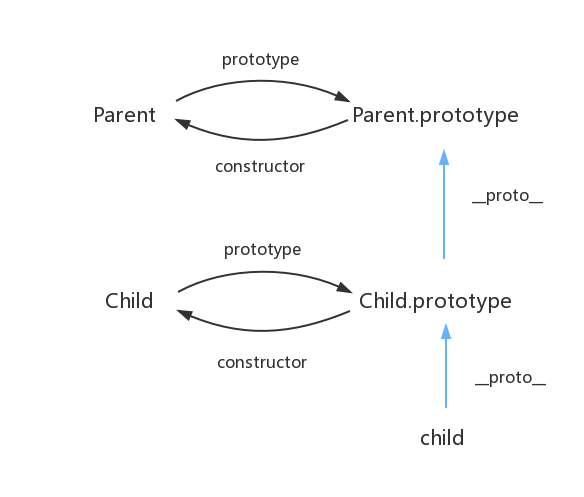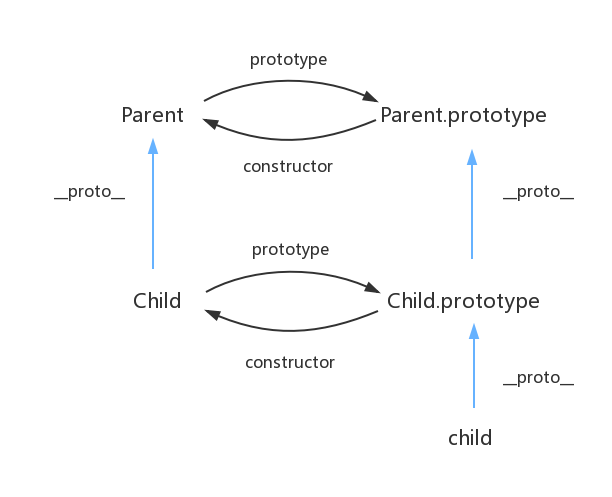摘要: ## 前言 在上一篇 [《 ES6 系列 Babel 是如何编译 Class 的(上)》](https://github.com/mqyqingfeng/Blog/issues/105),我们知道了 Babel 是如何编译 Class 的,这篇我们学习 Babel 是如何用 ES5 实现 Class 的继承。 ## ES5 寄生组合式继承 ```js function Pare
前言
在上一篇 《 ES6 系列 Babel 是如何编译 Class 的(上)》,我们知道了 Babel 是如何编译 Class 的,这篇我们学习 Babel 是如何用 ES5 实现 Class 的继承。
ES5 寄生组合式继承
function Parent (name) {
this.name = name;
}
Parent.prototype.getName = function () {
console.log(this.name)
}
function Child (name, age) {
Parent.call(this, name);
this.age = age;
}
Child.prototype = Object.create(Parent.prototype);
var child1 = new Child('kevin', '18');
console.log(child1);
原型链示意图为:

关于寄生组合式继承我们在 《JavaScript深入之继承的多种方式和优缺点》 中介绍过。
引用《JavaScript高级程序设计》中对寄生组合式继承的夸赞就是:
这种方式的高效率体现它只调用了一次 Parent 构造函数,并且因此避免了在 Parent.prototype 上面创建不必要的、多余的属性。与此同时,原型链还能保持不变;因此,还能够正常使用 instanceof 和 isPrototypeOf。开发人员普遍认为寄生组合式继承是引用类型最理想的继承范式。
ES6 extend
Class 通过 extends 关键字实现继承,这比 ES5 的通过修改原型链实现继承,要清晰和方便很多。
以上 ES5 的代码对应到 ES6 就是:
class Parent {
constructor(name) {
this.name = name;
}
}
class Child extends Parent {
constructor(name, age) {
super(name); // 调用父类的 constructor(name)
this.age = age;
}
}
var child1 = new Child('kevin', '18');
console.log(child1);
值得注意的是:
super 关键字表示父类的构造函数,相当于 ES5 的 Parent.call(this)。
子类必须在 constructor 方法中调用 super 方法,否则新建实例时会报错。这是因为子类没有自己的 this 对象,而是继承父类的 this 对象,然后对其进行加工。如果不调用 super 方法,子类就得不到 this 对象。
也正是因为这个原因,在子类的构造函数中,只有调用 super 之后,才可以使用 this 关键字,否则会报错。
子类的 __proto__
在 ES6 中,父类的静态方法,可以被子类继承。举个例子:
class Foo {
static classMethod() {
return 'hello';
}
}
class Bar extends Foo {
}
Bar.classMethod(); // 'hello'
这是因为 Class 作为构造函数的语法糖,同时有 prototype 属性和 __proto__ 属性,因此同时存在两条继承链。
(1)子类的 __proto__ 属性,表示构造函数的继承,总是指向父类。
(2)子类 prototype 属性的 __proto__ 属性,表示方法的继承,总是指向父类的 prototype 属性。
class Parent {
}
class Child extends Parent {
}
console.log(Child.__proto__ === Parent); // true
console.log(Child.prototype.__proto__ === Parent.prototype); // true
ES6 的原型链示意图为:

我们会发现,相比寄生组合式继承,ES6 的 class 多了一个 Object.setPrototypeOf(Child, Parent)的步骤。
继承目标
extends 关键字后面可以跟多种类型的值。
class B extends A {
}
上面代码的 A,只要是一个有 prototype 属性的函数,就能被 B 继承。由于函数都有 prototype 属性(除了 Function.prototype 函数),因此 A 可以是任意函数。
除了函数之外,A 的值还可以是 null,当 extend null 的时候:
class A extends null {
}
console.log(A.__proto__ === Function.prototype); // true
console.log(A.prototype.__proto__ === undefined); // true
Babel 编译
那 ES6 的这段代码:
class Parent {
constructor(name) {
this.name = name;
}
}
class Child extends Parent {
constructor(name, age) {
super(name); // 调用父类的 constructor(name)
this.age = age;
}
}
var child1 = new Child('kevin', '18');
console.log(child1);
Babel 又是如何编译的呢?我们可以在 Babel 官网的 Try it out 中尝试:
'use strict';
function _possibleConstructorReturn(self, call) {
if (!self) {
throw new ReferenceError("this hasn't been initialised - super() hasn't been called");
}
return call && (typeof call === "object" || typeof call === "function") ? call : self;
}
function _inherits(subClass, superClass) {
if (typeof superClass !== "function" && superClass !== null) {
throw new TypeError("Super expression must either be null or a function, not " + typeof superClass);
}
subClass.prototype = Object.create(superClass && superClass.prototype, { constructor: { value: subClass, enumerable: false, writable: true, configurable: true } });
if (superClass) Object.setPrototypeOf ? Object.setPrototypeOf(subClass, superClass) : subClass.__proto__ = superClass;
}
function _classCallCheck(instance, Constructor) {
if (!(instance instanceof Constructor)) {
throw new TypeError("Cannot call a class as a function");
}
}
var Parent = function Parent(name) {
_classCallCheck(this, Parent);
this.name = name;
};
var Child = function(_Parent) {
_inherits(Child, _Parent);
function Child(name, age) {
_classCallCheck(this, Child);
// 调用父类的 constructor(name)
var _this = _possibleConstructorReturn(this, (Child.__proto__ || Object.getPrototypeOf(Child)).call(this, name));
_this.age = age;
return _this;
}
return Child;
}(Parent);
var child1 = new Child('kevin', '18');
console.log(child1);
我们可以看到 Babel 创建了 _inherits 函数帮助实现继承,又创建了 _possibleConstructorReturn 函数帮助确定调用父类构造函数的返回值,我们来细致的看一看代码。
_inherits
function _inherits(subClass, superClass) {
// extend 的继承目标必须是函数或者是 null
if (typeof superClass !== "function" && superClass !== null) {
throw new TypeError("Super expression must either be null or a function, not " + typeof superClass);
}
// 类似于 ES5 的寄生组合式继承,使用 Object.create,设置子类 prototype 属性的 __proto__ 属性指向父类的 prototype 属性
subClass.prototype = Object.create(superClass && superClass.prototype, { constructor: { value: subClass, enumerable: false, writable: true, configurable: true } });
// 设置子类的 __proto__ 属性指向父类
if (superClass) Object.setPrototypeOf ? Object.setPrototypeOf(subClass, superClass) : subClass.__proto__ = superClass;
}
关于 Object.create(),一般我们用的时候会传入一个参数,其实是支持传入两个参数的,第二个参数表示要添加到新创建对象的属性,注意这里是给新创建的对象即返回值添加属性,而不是在新创建对象的原型对象上添加。
举个例子:
// 创建一个以另一个空对象为原型,且拥有一个属性 p 的对象
const o = Object.create({}, { p: { value: 42 } });
console.log(o); // {p: 42}
console.log(o.p); // 42
再完整一点:
const o = Object.create({}, {
p: {
value: 42,
enumerable: false,
// 该属性不可写
writable: false,
configurable: true
}
});
o.p = 24;
console.log(o.p); // 42
那么对于这段代码:
subClass.prototype = Object.create(superClass && superClass.prototype, { constructor: { value: subClass, enumerable: false, writable: true, configurable: true } });
作用就是给 subClass.prototype 添加一个可配置可写不可枚举的 constructor 属性,该属性值为 subClass。
_possibleConstructorReturn
函数里是这样调用的:
var _this = _possibleConstructorReturn(this, (Child.__proto__ || Object.getPrototypeOf(Child)).call(this, name));
我们简化为:
var _this = _possibleConstructorReturn(this, Parent.call(this, name));
_possibleConstructorReturn 的源码为:
function _possibleConstructorReturn(self, call) {
if (!self) {
throw new ReferenceError("this hasn't been initialised - super() hasn't been called");
}
return call && (typeof call === "object" || typeof call === "function") ? call : self;
}
在这里我们判断 Parent.call(this, name) 的返回值的类型,咦?这个值还能有很多类型?
对于这样一个 class:
class Parent {
constructor() {
this.xxx = xxx;
}
}
Parent.call(this, name) 的值肯定是 undefined。可是如果我们在 constructor 函数中 return 了呢?比如:
class Parent {
constructor() {
return {
name: 'kevin'
}
}
}
我们可以返回各种类型的值,甚至是 null:
class Parent {
constructor() {
return null
}
}
我们接着看这个判断:
call && (typeof call === "object" || typeof call === "function") ? call : self;
注意,这句话的意思并不是判断 call 是否存在,如果存在,就执行 (typeof call === "object" || typeof call === "function") ? call : self
因为 && 的运算符优先级高于 ? :,所以这句话的意思应该是:
(call && (typeof call === "object" || typeof call === "function")) ? call : self;
对于 Parent.call(this) 的值,如果是 object 类型或者是 function 类型,就返回 Parent.call(this),如果是 null 或者基本类型的值或者是 undefined,都会返回 self 也就是子类的 this。
这也是为什么这个函数被命名为 _possibleConstructorReturn。
总结
var Child = function(_Parent) {
_inherits(Child, _Parent);
function Child(name, age) {
_classCallCheck(this, Child);
// 调用父类的 constructor(name)
var _this = _possibleConstructorReturn(this, (Child.__proto__ || Object.getPrototypeOf(Child)).call(this, name));
_this.age = age;
return _this;
}
return Child;
}(Parent);
最后我们总体看下如何实现继承:
首先执行 _inherits(Child, Parent),建立 Child 和 Parent 的原型链关系,即 Object.setPrototypeOf(Child.prototype, Parent.prototype) 和 Object.setPrototypeOf(Child, Parent)。
然后调用 Parent.call(this, name),根据 Parent 构造函数的返回值类型确定子类构造函数 this 的初始值 _this。
最终,根据子类构造函数,修改 _this 的值,然后返回该值。
ES6 系列
ES6 系列目录地址:https://github.com/mqyqingfeng/Blog
ES6 系列预计写二十篇左右,旨在加深 ES6 部分知识点的理解,重点讲解块级作用域、标签模板、箭头函数、Symbol、Set、Map 以及 Promise 的模拟实现、模块加载方案、异步处理等内容。













